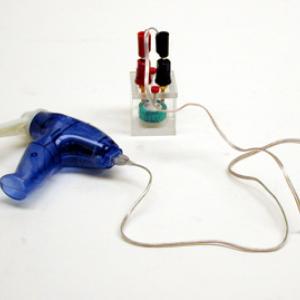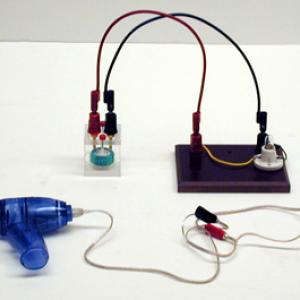College of Liberal Arts & Sciences
5C30.38 - Capacitor - Charge & Discharge - Genecon Generator
The Genecon generator and the 1 farad capacitor make a fine demo because the generator will also run as a motor. This means that you can show a relationship between energy put into a capacitor and that taken out. Hook the generator to the 1 farad capacitor after making sure the capacitor is discharged. Charge the capacitor and count the number of turns you put in. Let go of the generator handle and the stored energy in the capacitor will make the generator run as a motor. Count the number of turns the handle makes in this cycle. There will almost be a direct 1 to 1 relationship (ie. 10 turns put into the capacitor, 9 1/2 turns out).
Interestingly enough the handle will turn in the same direction that you were turning it when you charged the capacitor.
Capacitor: you crank the generator handle as you charge it and current flows into it. You have to apply a torque to because the current flowing in the generator makes it want to act like a motor in turing in the opposite direction. You release the handle and now the capacitor discharges and current flows in the opposite direction. This causes the handle to turn in the origional direction.
Coil: you crank the generator applying a torque. Again, because the generator acts like a motor it resists your efforts forcing you and to do work. You release the handle, the current keeps flowing in the same direction (Lenz's Law). This results in a torque in the same direction that registered your efforts origionally and the handle changes direction.
Details of why this is can be found in the file.
A subtle comparison can be made between an inductor and a capacitor using a hand crank DC generator. When connected to the capacitor, the generator is hard to crank at first and gets easier to crank as you continue. When you quit cranking the generator will keep going on its own in the same direction as you cranked it. Do the same with an inductor and it gets harder to crank as you continue and when you let go, it stops and turns in the opposite direction you originally cranked it.
- Douglas T. Young, "Determining Charge Stored on a Capacitor Using Numerical Integration with a Spreadsheet", TPT, Vol. 61, #1, Jan. 2023, p. 31.
- Carl E. Mungan, "...And Hand-Cranked Induction", TPT, Vol. 52, #9, Dec. 2014, p. 518.
- Art Hovey, "Hand-Cranked Intuition", TPT, Vol. 52, #9, Dec. 2014, p. 518.
- Carl. E. Mungan, "Motor Demonstration Using a Hand-Cranked Genecon", TPT, Vol. 52, #7, Oct. 2014, p. 422.
- Robert Ehrlich, "9.4, A Generator and a Capacitor", Why Toast Lands Jelly-Side Down, p. 149.
- Tap-l conversations, Genecon - Charge a Cap and a Coil, 9-25-2018.
Disclaimer: These demonstrations are provided only for illustrative use by persons affiliated with The University of Iowa and only under the direction of a trained instructor or physicist. The University of Iowa is not responsible for demonstrations performed by those using their own equipment or who choose to use this reference material for their own purpose. The demonstrations included here are within the public domain and can be found in materials contained in libraries, bookstores, and through electronic sources. Performing all or any portion of any of these demonstrations, with or without revisions not depicted here entails inherent risks. These risks include, without limitation, bodily injury (and possibly death), including risks to health that may be temporary or permanent and that may exacerbate a pre-existing medical condition; and property loss or damage. Anyone performing any part of these demonstrations, even with revisions, knowingly and voluntarily assumes all risks associated with them.

